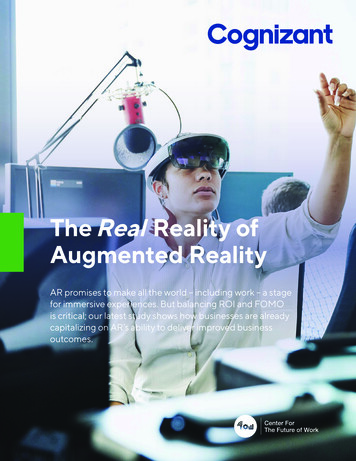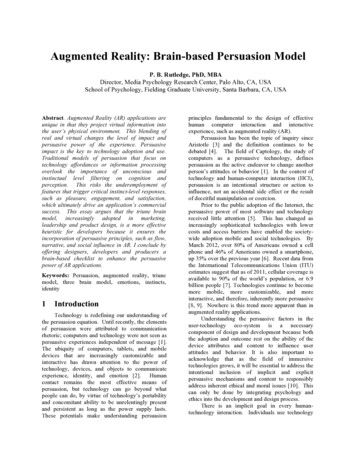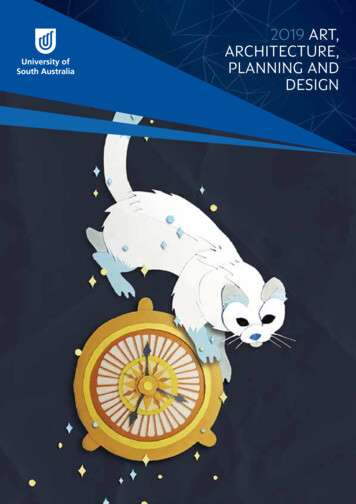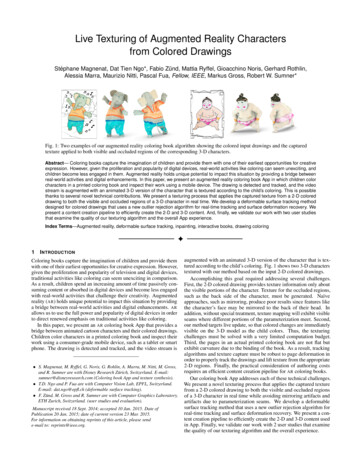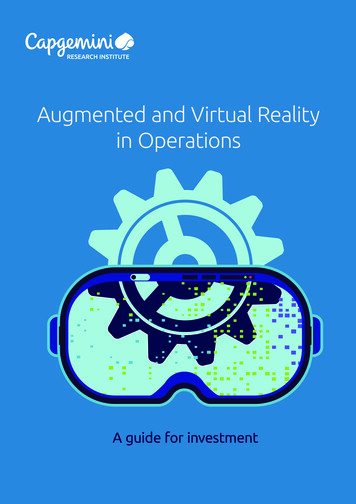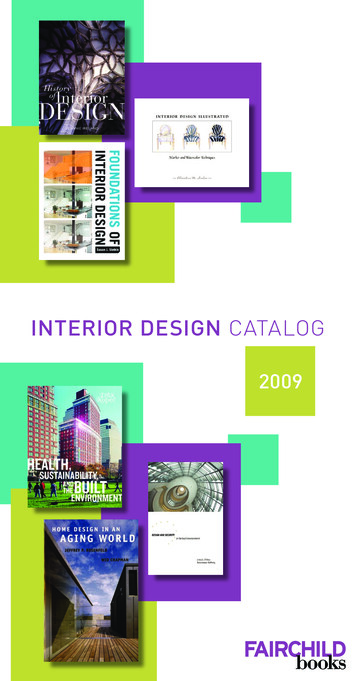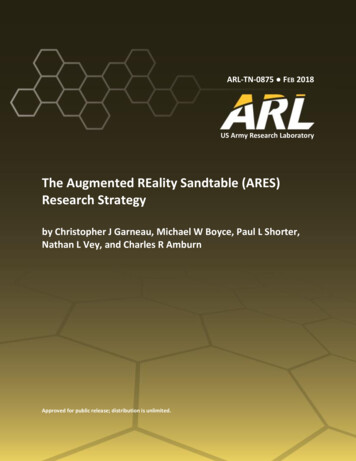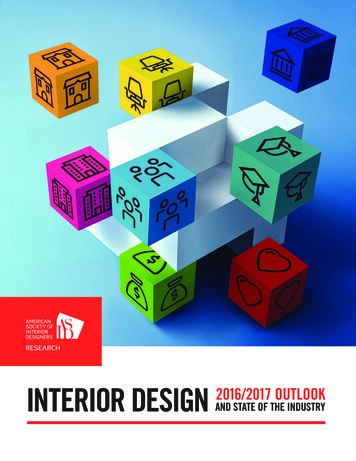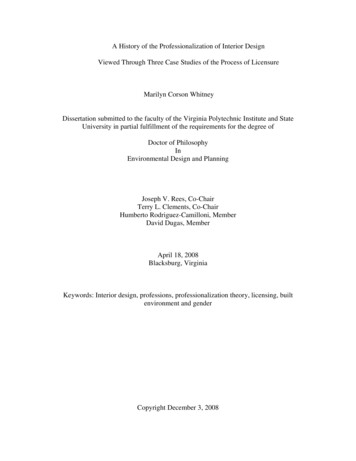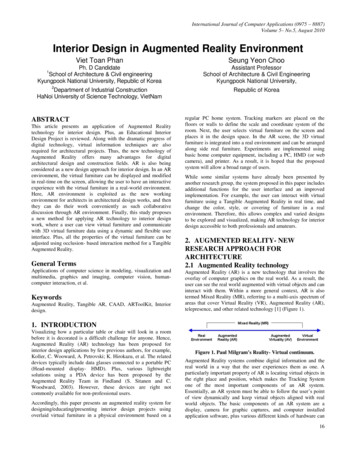
Transcription
International Journal of Computer Applications (0975 – 8887)Volume 5– No.5, August 2010Interior Design in Augmented Reality EnvironmentViet Toan PhanSeung Yeon ChooPh. D Candidate1School of Architecture & Civil engineeringKyungpook National University, Republic of KoreaAssistant ProfessorSchool of Architecture & Civil EngineeringKyungpook National University,2Department of Industrial ConstructionHaNoi University of Science Technology, VietNamABSTRACTThis article presents an application of Augmented Realitytechnology for interior design. Plus, an Educational InteriorDesign Project is reviewed. Along with the dramatic progress ofdigital technology, virtual information techniques are alsorequired for architectural projects. Thus, the new technology ofAugmented Reality offers many advantages for digitalarchitectural design and construction fields. AR is also beingconsidered as a new design approach for interior design. In an ARenvironment, the virtual furniture can be displayed and modifiedin real-time on the screen, allowing the user to have an interactiveexperience with the virtual furniture in a real-world environment.Here, AR environment is exploited as the new workingenvironment for architects in architectural design works, and thenthey can do their work conveniently as such collaborativediscussion through AR environment. Finally, this study proposesa new method for applying AR technology to interior designwork, where a user can view virtual furniture and communicatewith 3D virtual furniture data using a dynamic and flexible userinterface. Plus, all the properties of the virtual furniture can beadjusted using occlusion- based interaction method for a TangibleAugmented Reality.General TermsApplications of computer science in modeling, visualization andmultimedia, graphics and imaging, computer vision, humancomputer interaction, et al.KeywordsAugmented Reality, Tangible AR, CAAD, ARToolKit, Interiordesign.Republic of Korearegular PC home system. Tracking markers are placed on thefloors or walls to define the scale and coordinate system of theroom. Next, the user selects virtual furniture on the screen andplaces it in the design space. In the AR scene, the 3D virtualfurniture is integrated into a real environment and can be arrangedalong side real furniture. Experiments are implemented usingbasic home computer equipment, including a PC, HMD (or webcamera), and printer. As a result, it is hoped that the proposedsystem will allow a broad range of users.While some similar systems have already been presented byanother research group, the system proposed in this paper includesadditional functions for the user interface and an improvedimplementation. For example, the user can interact with virtualfurniture using a Tangible Augmented Reality in real time, andchange the color, style, or covering of furniture in a realenvironment. Therefore, this allows complex and varied designsto be explored and visualized, making AR technology for interiordesign accessible to both professionals and amateurs.2. AUGMENTED REALITY- NEWRESEARCH APPROACH FORARCHITECTURE2.1 Augmented Reality technologyAugmented Reality (AR) is a new technology that involves theoverlay of computer graphics on the real world. As a result, theuser can see the real world augmented with virtual objects and caninteract with them. Within a more general context, AR is alsotermed Mixed Reality (MR), referring to a multi-axis spectrum ofareas that cover Virtual Reality (VR), Augmented Reality (AR),telepresence, and other related technology [1] (Figure 1).1. INTRODUCTIONVisualizing how a particular table or chair will look in a roombefore it is decorated is a difficult challenge for anyone. Hence,Augmented Reality (AR) technology has been proposed forinterior design applications by few previous authors, for example,Koller, C. Wooward, A. Petrovski; K. Hirokazu, et al. The relateddevices typically include data glasses connected to a portable PC(Head-mounted display- HMD). Plus, various lightweightsolutions using a PDA device has been proposed by theAugmented Reality Team in Findland (S. Sitanen and C.Woodward, 2003). However, these devices are right notcommonly available for non-professional users.Accordingly, this paper presents an augmented reality system fordesigning/educating/presenting interior design projects usingoverlaid virtual furniture in a physical environment based on aFigure 1. Paul Milgram’s Reality- Virtual continuum.Augmented Reality systems combine digital information and thereal world in a way that the user experiences them as one. Aparticularly important property of AR is locating virtual objects inthe right place and position, which makes the Tracking Systemone of the most important components of an AR system.Essentially, an AR system must be able to follow the user’s pointof view dynamically and keep virtual objects aligned with realworld objects. The basic components of an AR system are adisplay, camera for graphic captures, and computer installedapplication software, plus various different kinds of hardware can16
International Journal of Computer Applications (0975 – 8887)Volume 5– No.5, August 2010be used, for example, camera phones, PDAs, lap-tops, HMDs, andwearable computer systems.Typically, an ARToolKit library is used to determine the relationbetween the real and virtual world. The ARToolKit uses acomputer vision technique to define the position and orientationof the real camera viewpoint relative to a real world marker. Next,the ARToolKit defines and calculates the position of the virtualcoordinates. Based on a concurrence of virtual and real cameracoordinates, the computer graphics are then drawn as an overlayon a fiducial markers card. As a result, the user experiences avideo see-through augmented reality on the PC screen or morelively impression by HMDs (Kato, H.2001 and HIT LabWashington University).Although Augmented Reality has only been studied for onedecade, the growth and progress in the past few years have beenremarkable. As such, AR technology has many possibleapplications across a wide range of fields, includingentertainment, education, medicine, military training, engineering,and manufacturing [2](Figure 2; 3).2.2 Augmented Reality in architecture fieldRecently, AR technology is also being considered as a new designapproach for architecture. As a result, a lot of AR experiments andresearch have been directed toward the architectural designprocess. For example, Figure 4 Left shows a full-size 3D virtualhouse in a real life environment, where the handheld AR deviceallows the user to walk around and through it [3](AugmentedTeam- Finland 2003). Meanwhile, Figure 4- Right shows anotherimplementation of AR in archaeology and touring guide, wherethe user is shown the virtual heritage buildings raised up fromruins on historical site.Figure 4. Left: Virtual building in PDA. Right: Virtual Heratemple in historical.In the case of architecture, the above applications can be effectivefor both designing and teaching. However, a growing number ofnew applications of AR technology are expected in the field ofarchitecture.Figure 2. AR application in entertainment and medical fields.3. INTERIOR DESIGN IN DIGITALENVIRONMENT3.1 Properties of interior designIn the case of interior design, the designer essentially applies thethree basic principles of interior design: color, scale, andproportion within a predetermined space. Thus, the proposed ARsystem is focused on giving the user the flexibility to design usingthese three basic principles. Therefore, in the proposed ARenvironment, the user is able to adjust the properties of virtualfurniture and create different arrangements in a real environment.3.2 System designFigure 3. AR application in military and manufactureengineering fields.It is also expected that other potential areas for application willstill appear with the dissemination of this technology. During theearly stages, the main focus of AR development was related tohardware technology rather than usability. However, the rapiddevelopment of mobile (handheld) with better processingcapacities and long-lasting batteries has raised the issue oflightweight mobile AR systems. Thus, mobile AR devices are nowone of the most promising emerging technologies. Similarly, theproposed system was also designed to appeal to a broader range ofusers based on the use of a regular PC and HMD.For implementation, two separate modules were developed: onefor creating and managing the 3D database, and the other fordisplaying, as show in below figure (Figure 5).First, CAD applications extract information from a drawing andlink it to a database. For the given space, geometrical informationis then extracted from a three-dimensional database of furniture.After loading the geometries, the position and direction of theviews for the user are calculated based on data marker tracking.Simultaneously, the location- and direction- based geometry dataare transformed using transformation matrices to produce imagesthat align beside other objects in the real view. As such, theposition tracker and orientation tracker are important elements ofAR systems and the development AR technology. Figure 6summaries the tracking and display process.17
International Journal of Computer Applications (0975 – 8887)Volume 5– No.5, August 2010Figure 5. System diagram.The properties of the furniture graphics are saved in a databasegenerated by a CAD application, e.g. 3DSMax software, whileOpenGL renders the final graphics. Plus, an ARToolKit softwarelibrary is used to calculate the 3D positions and orientations of thevirtual furniture.ARToolKit software uses computer vision algorithms to solve thisproblem. An ARToolKit video tracking library defines the virtualcamera position and orientation relative to physical markers inreal time. The ARToolKit library- the product of HIT Lab NZ- isthen used to display the virtual objects.3.4 HardwareIn the present study, the AR system is based on a regular PC witha Windows XP operating system running on an Intel (R)Core(TM) Quad CPU Q6600 with 2GB of RAM. Plus, a webcam,Logitech Quickcam Vision Pro, is used to capture the senseimages. The user’s camera is capable of detecting known patternsfrom a single image and calculating the 3D position andorientation for world-space. The virtual objects (furniture,partitions, walls, doors, etc.) are then superimposed based onmarker tracking.Figure 6. AR tracking& display process: the computergenerated graphics are integrated into user’s view.3.3 SoftwareCAD applications handle the management of the buildinggeometry data and link it to a database. Next, the AR softwareretrieves and displays the position and orientation data in thedefined environment.The 3DSMax or other Building Information Modelling (BIM)applications (e.g. ArchiCAD, Revit etc.) are used as the basicsoftware for the CAD applications and also provides customizedsupport for ARToolKit- 2.72.1. The 3DSMax (and others)produces a VRML file of a model which has a type *.wrlextension. An ARToolKit library then assumes the role ofbuilding the AR application. One of the key difficulties involvedin developing an AR application is tracking the user’s viewpoint.In order to determine which viewpoint to use to align the virtualimagery with real-world objects, the AR application first needs todetermine the viewpoint of the user in the real world.Figure 7. Left: Fiducial marker patterns. Right: Sub-markercard for Tangible AR control.Some of the tracking markers used by an ARToolKit library arevery precise and robust. In this study, mk patt.exe files were usedto generate various image markers from a blankPatt.gif patterndirectory. For implementation, several marker patterns and submarker templates for Tangible AR were made beforehand.The Head-Mounted Display (HMD) also is equipped for user inthe practical implementation. By using HMD for AR display, theuser can move freely around virtual furniture when they areviewing it. The figure 8 shows an example of how the components18
International Journal of Computer Applications (0975 – 8887)Volume 5– No.5, August 2010of AR system working together to produce the final results onvideo eye-monitors.When multiple interaction markers are placed in a line, theneighbors of the interaction marker being tested can also betreated as boundary markers. These markers are referred to ashybrid markers (Figure 10). The tested marker within the viewvolume whenever there is at least one visible boundary (or hybrid)marker on each side. Thus, hybrid markers act as both boundariesand an interaction point. In this way, the occlusion of multipleconsecutive markers can also be detected, as well as allowing theboundary markers to be out of view.Figure 8. Schematic illustration of video overlaid- basedAugmented Reality& VR Pro AR 800x600 HMD.3.5 Interaction method on occlusion markersfor Tangible ARThis paper applies an interaction object- centered view to 2Dinteractions, which is easy to apply to Tangible AR environmentswhere natural interaction methods are vital. In the real world,humans are able to use a variety of objects or bare fingers as apointer. In addition, for some situations with multiple participantsor bi-manual interactions, the interaction can even involvemultiple pointers.Detecting pointers over an interaction object can be achieved innumerous ways, where detecting the occlusions of the trackedobject is a passive way to detect pointing actions. The occlusionsof an interaction object can be easily utilized as an interactionmethod in Tangible AR environments in which a camera isalready available for providing real-world views to the user andtracking the objects of interest with passive formal markers.For occlusion detection, predefined formal markers are widelyused for tracking real objects in Tangible AR environments.Vision-based tracking systems usually require multiple markersfor tracking one object. A number of markers are attached to asingle object in a pre-configured spatial relationship. In this way,the object can be tracked successfully even if some of markers inthe marker set are not visible. In addition, because the spatialrelationships of all the markers are known, the poses of markersthat are not visible can be estimated using the markers that arerecognized.A simple way to guarantee that a marker is within the viewvolume is to check the visibility of its neighboring markers,referred to as boundary markers, while a marker being checkedfor occlusion is referred to an interaction marker.To guarantee that an interaction marker is within the view volume,the boundary markers must be carefully placed. The convex hullof the boundary markers must include the interaction marker. Forinstance, for a single interaction marker, at least 2 boundarymarkers are needed surrounding the interaction marker (Figure 9).By checking whether these boundary markers are visible, theinteraction marker can be guaranteed to be within the viewvolume, making it occluded if it is not detected.Figure 9. Boundary markers around interaction markers.Figure 10. Hybrid markers: center hybrid marker plays role ofboundary marker for left hybrid marker.Although the boundary marker method is simple to implementand works reliably, marker wastage is unavoidable, sinceadditional non- interactable boundary markers are required. Plus,interaction is little difficult, as the user has to make sure thatenough boundary markers are within the current view.3.6 Interaction virtual furniture usingTangible ARTangible Augmented Reality interfaces combine a tangible userinterface and augmented reality technology. In the present study,virtual furniture is modified using an occlusion- based interfacefor Tangible AR effects. Tangible AR interfaces are where eachvirtual object is registered to a physical object, and a user interactswith the virtual objects by manipulating the correspondingphysical objects. In this case, occlusion is a simple way ofcompleting interactions based on hiding the formal markers frombeing tracked. In this study, two sub-marker band cards are made,where one controls the color and the other controls the material ofthe virtual furniture. In particular, these marker templates arecombined from several unit markers (Figure 7-Right).Each unit marker corresponds to one option. In the implementedAR system, the user takes first sub-marker band card to create avirtual chair. The user can hide one unit marker using one finger.A new corresponding color is then assigned to the virtual chair.Next, the user moves the second sub-marker band card to connectwith the first one in order to adjust the color volume. Thecorresponding virtual color slide is then added as an overlay forthis band card. Changing the effect of the virtual color slide canbe redefined based on the position of the hidden unit marker withthe user’s finger. Thus, the effect of changing the color of thevirtual chair corresponds with the hidden point situation of thevirtual color slide being shown.Figure 11. Left: Multi-class marker prototype; Right: Userassembling separate parts of Multi-Class marker.19
International Journal of Computer Applications (0975 – 8887)Volume 5– No.5, August 2010This study also uses a control method based on Multi-Classmarker (Figure 11- Left), which is explored based on anidentifiable ability image fiducial marker in the computer-visionprocess. In fact, a Multi-Class marker combines the functions ofseveral unit marker values. The operating control of a Multi-Classmarker is through user assembling unit markers. Theoretically,several unit marker values can be created within one Multi-Classmarker. Yet, in this study, one Multi-Class marker consists of sixunit marker values. The cause of this limit is the graphicidentifiable ability of a web camera. In the present study, theMulti-Class marker covers the entire virtual graphics of the ARoperation, and the user can also order more furniture when moreunit marker classes are fixed.The next section shows the interaction with virtual furniture toproduce a Tangible AR effect with an AR interface.4. IMPLEMENTATIONThe operation of the system is described in the followingparagraphs. First, the user prints out the markers that will be used,where the style and size of the markers can be defined from theuser interface in order to adapt it to the environment (i.e. viewingdistance and size of the room). As the user walks around the room,they take a series of capture marker images with a digital camera.These marker images are then upload to the AR software as themarker tracking stage. Thereafter, the furniture augmentingsystem is started.The system includes functions for handling images, moving wrlmodels and re-sizing them, and defining marker properties andthreshold values for manipulating objects. The user selectsdifferent pieces of (virtual) furniture from the object list on theleft, then adds, deletes, or modifies the properties, and hides themas required. Each object first appears on the marker card, however,the user also can move an object to the desired position bydragging it with a mouse, or modify the threshold values of thecoordinates. Many AR applications use fixed directions in themarker coordinates. As a result, when looking from an oppositedirection, the object is moved to an unnatural direction. Incontrast, the proposed approach is more natural for usermanipulation, as no knowledge is required of the markercoordinates. First, a virtual chair and meeting table are assigned asthe main samples in the present AR experiment. Once the virtualfurniture has been arranged, the user can adjust the scale usingdigital images on the screen or a control marker band through aTangible AR effect. In the AR photos, the user keeps the controlmarker template in their hand as they approach the virtualfurniture. The virtual adjusted slide appears on the control markertemplate, allowing the user to interact with the virtual furniturethrough manipulating the control marker band (unit markers mustbe hidden using the fingers).In another phase, if the user wants to place a sample partition inthe room, the user can order a virtual partition to appear in theappropriate position. Yet, difficulties occur when the camera hasdifficulty viewing the tracking markers in the case of virtual andreal furniture being added in the same space. With the proposedsystem, the implementation allows the user to change the threedimensional relationship between the virtual furniture and themarker images. Thus, the user can place a marker in any freeposition so that the camera can view it clearly. As with all virtualfurniture, the properties of a partition or any virtual furniture canbe modified in real time using the Tangible AR effect.All the images and virtual models are loaded onto the systemdynamically. Furthermore, the state of the virtual furnishingdesign can be saved in a project file, which can then be loadedlater when the user decides to continue working their design.Figure 12. Two-phase AR scene- user adjusts color of virtual furniture20
International Journal of Computer Applications (0975 – 8887)Volume 5– No.5, August 2010Figure 13. Chair base is moved on floor plan graphic& the statue is added on table using AR interior design interface.5. CONCLUSIONThis research examined virtual furniture and adjustment work tocreate a new design method using Augmented Reality technologyfor Interior Design education.In particular, AR technology opens up many new research fieldsin engineering and architecture. In an AR environment, designwork can become more lively, convenient, and intelligent. Plus,design work and manufacturing can be conducted at the same timeand we close relationship with each other. With AR, the virtualproducts of graphic technology are not only for simulation butalso obtain real higher values.Furthermore, AR technology can become a new animatedsimulation tool for interior design, allowing the user to see amixed AR scene through HMD, video display, or PDA. It is alsoanticipated that the interactive potential can be increasedaccording to the user’s needs.6. ACKNOWLEDGMENTSThis research was supported by Basic Science Research Programthrough the National Research Foundation of Korea (NRF)funded by the Ministry of Education, Science and Technology(2010-0015999).7. REFERENCES[4] Billinghurst, M., Kate, H., and Proupyrev, I. 2001. TheMagicBook-Moving Seamlessly between Reality and VirtualIEEE Computer Graphics and Applications, Vol.21, No.3, 24.[5] Siltanen, S., and Woodward, C. 2006. Augmented interiorswith digital camera images. In Proceedings of SeventhAustralian User Interface Conference, Australia CRPIT, 3336.[6] Pasman, W., Woodward, C. 2003. Implementation of anAugmented Reality System on a PDA. Symposium of Mixedand Augmented Reality, ISMAR 2003, Tokyo, Japan.[7] Phan, V. T., Choo, S. Y. 2010. A Combination ofAugmented Reality and Google Earth’s facilities for urbanplanning in idea stage. International Journal of ComputerApplications, Published by Foundation of Computer Science,USA, vol. 4, No. 3, 26- 34.[8] Sherman, W. and Craig, A. 2003. Understanding VirtualReality: Interface, Application and Design. Morgan KaufmanPublisher.[9] Kensek, K., Noble, D., Schiler, M. and Triparthi, A. 2000.Augmented Reality: An application for architecture. InProceedings 8th International Conference on Computing inCivil and Building Engineering, ASCE, Stanford, CA, 294301.[1] Milgram, P., Takemura, H., Utsumi, A., and Kishimo, F.1994. Augmented reality: A class of displays on the realityvirtual continuum. In Proceedings Telemanipulator andTelepresence Technologies: 2351-34, Retrieve 2007-03-15.[10] Dias, J. M. S., Santos, P., Nande, P. 2003. In Your HandComputing: Tangible Interfaces for Mixed Reality. InProceedings of 2nd IEEE International Augmented RealityToolKit Workshop, Waseda University, Tokyo, Japan.[2] Azuma, R. 1997. A survey of Augmented Reality.InPresence: Teleoperators and Virtual Environment 6, 4(August 1997), 355-385.[11] Vallino, J. R. 1998. Interactive Augmented Reality. Doctorof Philosophy Thesis, University of Rochester, New York.[3] Woodward, C., Lahti, J., Rökkö, J., Honkamaa, P., Jäppinen,J., Rainio, K., and et al. 2007. Virtual and augmented realityin the digital building project. International Journal ofDesign Science and Technology, Vol.14, No.1, 23-40.21
3. INTERIOR DESIGN IN DIGITAL ENVIRONMENT 3.1 Properties of interior design In the case of interior design, the designer essentially applies the three basic principles of interior design: color, scale, and proportion within a predetermined space. Thus, the proposed AR system is f

